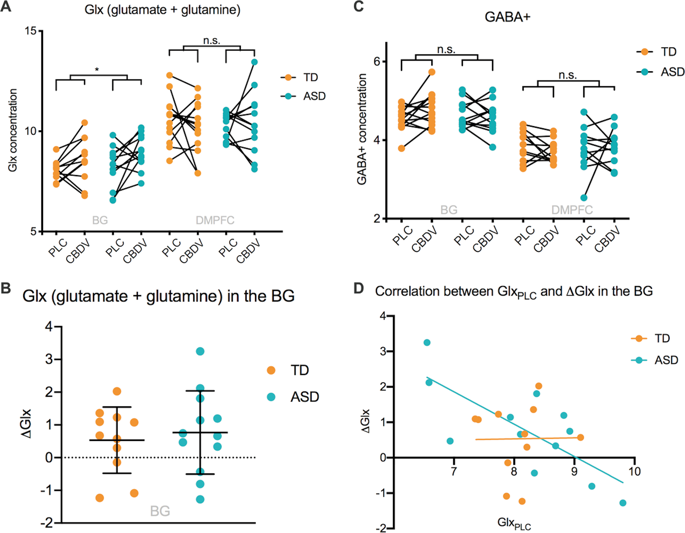当前位置:
X-MOL 学术
›
Transl. Psychiaty
›
论文详情
Our official English website, www.x-mol.net, welcomes your
feedback! (Note: you will need to create a separate account there.)
Effects of cannabidivarin (CBDV) on brain excitation and inhibition systems in adults with and without Autism Spectrum Disorder (ASD): a single dose trial during magnetic resonance spectroscopy.
Translational Psychiatry ( IF 5.8 ) Pub Date : 2019-11-20 , DOI: 10.1038/s41398-019-0654-8 Charlotte M Pretzsch 1 , Bogdan Voinescu 1 , David Lythgoe 2 , Jamie Horder 1 , Maria Andreina Mendez 1 , Robert Wichers 1 , Laura Ajram 1 , Glynis Ivin 3 , Martin Heasman 3 , Richard A E Edden 4 , Steven Williams 2 , Declan G M Murphy 1 , Eileen Daly 1 , Gráinne M McAlonan 1
Translational Psychiatry ( IF 5.8 ) Pub Date : 2019-11-20 , DOI: 10.1038/s41398-019-0654-8 Charlotte M Pretzsch 1 , Bogdan Voinescu 1 , David Lythgoe 2 , Jamie Horder 1 , Maria Andreina Mendez 1 , Robert Wichers 1 , Laura Ajram 1 , Glynis Ivin 3 , Martin Heasman 3 , Richard A E Edden 4 , Steven Williams 2 , Declan G M Murphy 1 , Eileen Daly 1 , Gráinne M McAlonan 1
Affiliation

|
Autism spectrum disorder (ASD) is a high cost neurodevelopmental condition; and there are currently no effective pharmacological treatments for its core symptoms. This has led some families and researchers to trial alternative remedies - including the non-intoxicating Cannabis sativa-derived compound cannabidivarin (CBDV). However, how CBDV affects the human brain is unknown. Previous (pre)clinical evidence suggests that CBDV may modulate brain excitatory-inhibitory systems, which are implicated in ASD. Hence, our main aim was to test, for the first time, if CBDV shifts glutamate and/or GABA metabolites - markers of the brain's primary excitatory and inhibitory system - in both the 'typical' and autistic brain. Our subsidiary aim was to determine whether, within ASD, brain responsivity to CBDV challenge is related to baseline biological phenotype. We tested this using a repeated-measures, double-blind, randomized-order, cross-over design. We used magnetic resonance spectroscopy (MRS) to compare glutamate (Glx = glutamate + glutamine) and GABA + (GABA + macromolecules) levels following placebo (baseline) and 600 mg CBDV in 34 healthy men with (n = 17) and without (n = 17) ASD. Data acquisition from regions previously reliably linked to ASD (dorsomedial prefrontal cortex, DMPFC; left basal ganglia, BG) commenced 2 h (peak plasma levels) after placebo/CBDV administration. Where CBDV significantly shifted metabolite levels, we examined the relationship of this change with baseline metabolite levels. Test sessions were at least 13 days apart to ensure CBDV wash-out. CBDV significantly increased Glx in the BG of both groups. However, this impact was not uniform across individuals. In the ASD group, and not in the typically developing controls, the 'shift' in Glx correlated negatively with baseline Glx concentration. In contrast, CBDV had no significant impact on Glx in the DMPFC, or on GABA+ in either voxel in either group. Our findings suggest that, as measured by MRS, CBDV modulates the glutamate-GABA system in the BG but not in frontal regions. Moreover, there is individual variation in response depending on baseline biochemistry. Future studies should examine the effect of CBDV on behaviour and if the response to an acute dose of CBDV could predict a potential clinical treatment response in ASD.
中文翻译:

大麻二酚 (CBDV) 对患有和不患有自闭症谱系障碍 (ASD) 的成人大脑兴奋和抑制系统的影响:磁共振波谱学期间的单剂量试验。
自闭症谱系障碍 (ASD) 是一种代价高昂的神经发育疾病;目前尚无针对其核心症状的有效药物治疗方法。这导致一些家庭和研究人员尝试替代疗法,包括无毒的大麻衍生化合物大麻二酚 (CBDV)。然而,CBDV 如何影响人脑尚不清楚。先前的(前)临床证据表明 CBDV 可能调节大脑兴奋-抑制系统,这与自闭症谱系障碍有关。因此,我们的主要目的是首次测试 CBDV 是否会改变“典型”大脑和自闭症大脑中的谷氨酸和/或 GABA 代谢物(大脑主要兴奋和抑制系统的标志物)。我们的次要目标是确定在 ASD 中,大脑对 CBDV 挑战的反应是否与基线生物表型相关。我们使用重复测量、双盲、随机顺序、交叉设计对此进行了测试。我们使用磁共振波谱 (MRS) 比较了 34 名服用 (n = 17) 和未服用 (n = 17) 的健康男性服用安慰剂(基线)和 600 mg CBDV 后的谷氨酸(Glx = 谷氨酸 + 谷氨酰胺)和 GABA +(GABA + 大分子)水平。 = 17) 自闭症谱系障碍。安慰剂/CBDV给药后2小时(峰值血浆水平)开始从先前与ASD可靠相关的区域(背内侧前额叶皮层,DMPFC;左基底神经节,BG)采集数据。当 CBDV 显着改变代谢水平时,我们检查了这种变化与基线代谢水平的关系。测试间隔至少 13 天,以确保 CBDV 被清除。 CBDV 显着增加了两组 BG 中的 Glx。然而,这种影响在个体之间并不统一。 在自闭症谱系障碍组中,Glx 的“变化”与基线 Glx 浓度呈负相关,而在典型发育的对照中则不然。相比之下,CBDV 对 DMPFC 中的 Glx 或任一组中任一体素中的 GABA+ 没有显着影响。我们的研究结果表明,根据 MRS 测量,CBDV 调节 BG 中的谷氨酸-GABA 系统,但不调节额叶区域。此外,根据基线生物化学,反应存在个体差异。未来的研究应该检查 CBDV 对行为的影响,以及对急性剂量 CBDV 的反应是否可以预测 ASD 的潜在临床治疗反应。
更新日期:2019-11-21
中文翻译:

大麻二酚 (CBDV) 对患有和不患有自闭症谱系障碍 (ASD) 的成人大脑兴奋和抑制系统的影响:磁共振波谱学期间的单剂量试验。
自闭症谱系障碍 (ASD) 是一种代价高昂的神经发育疾病;目前尚无针对其核心症状的有效药物治疗方法。这导致一些家庭和研究人员尝试替代疗法,包括无毒的大麻衍生化合物大麻二酚 (CBDV)。然而,CBDV 如何影响人脑尚不清楚。先前的(前)临床证据表明 CBDV 可能调节大脑兴奋-抑制系统,这与自闭症谱系障碍有关。因此,我们的主要目的是首次测试 CBDV 是否会改变“典型”大脑和自闭症大脑中的谷氨酸和/或 GABA 代谢物(大脑主要兴奋和抑制系统的标志物)。我们的次要目标是确定在 ASD 中,大脑对 CBDV 挑战的反应是否与基线生物表型相关。我们使用重复测量、双盲、随机顺序、交叉设计对此进行了测试。我们使用磁共振波谱 (MRS) 比较了 34 名服用 (n = 17) 和未服用 (n = 17) 的健康男性服用安慰剂(基线)和 600 mg CBDV 后的谷氨酸(Glx = 谷氨酸 + 谷氨酰胺)和 GABA +(GABA + 大分子)水平。 = 17) 自闭症谱系障碍。安慰剂/CBDV给药后2小时(峰值血浆水平)开始从先前与ASD可靠相关的区域(背内侧前额叶皮层,DMPFC;左基底神经节,BG)采集数据。当 CBDV 显着改变代谢水平时,我们检查了这种变化与基线代谢水平的关系。测试间隔至少 13 天,以确保 CBDV 被清除。 CBDV 显着增加了两组 BG 中的 Glx。然而,这种影响在个体之间并不统一。 在自闭症谱系障碍组中,Glx 的“变化”与基线 Glx 浓度呈负相关,而在典型发育的对照中则不然。相比之下,CBDV 对 DMPFC 中的 Glx 或任一组中任一体素中的 GABA+ 没有显着影响。我们的研究结果表明,根据 MRS 测量,CBDV 调节 BG 中的谷氨酸-GABA 系统,但不调节额叶区域。此外,根据基线生物化学,反应存在个体差异。未来的研究应该检查 CBDV 对行为的影响,以及对急性剂量 CBDV 的反应是否可以预测 ASD 的潜在临床治疗反应。











































 京公网安备 11010802027423号
京公网安备 11010802027423号